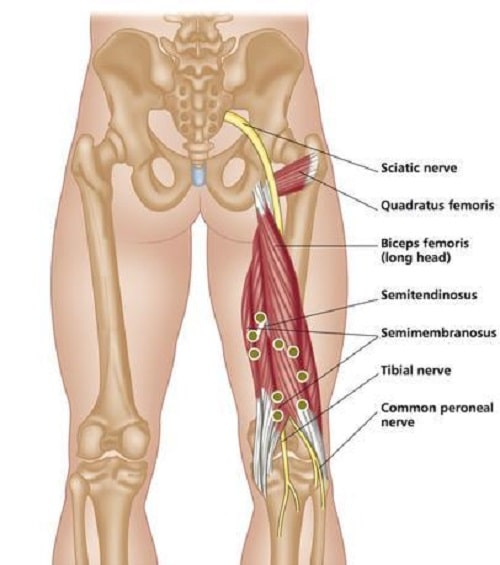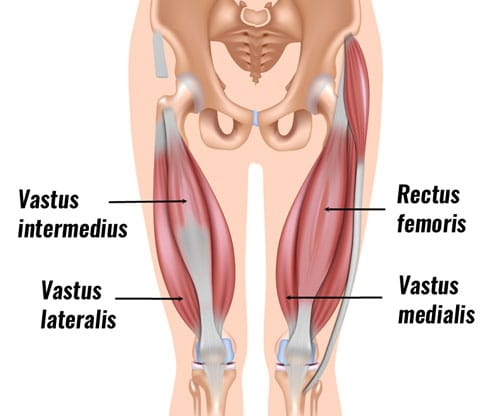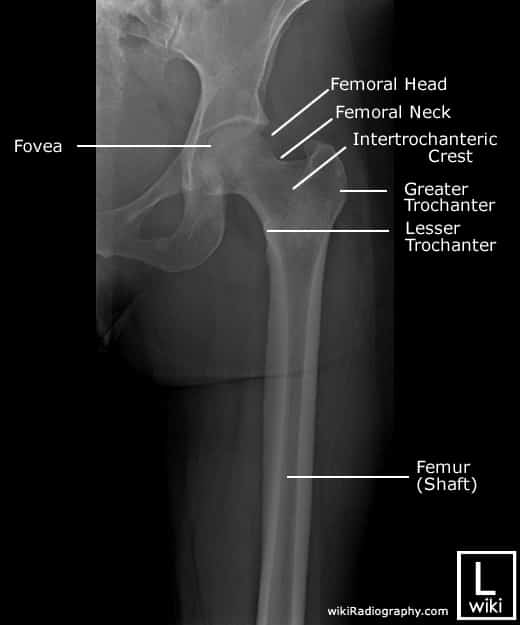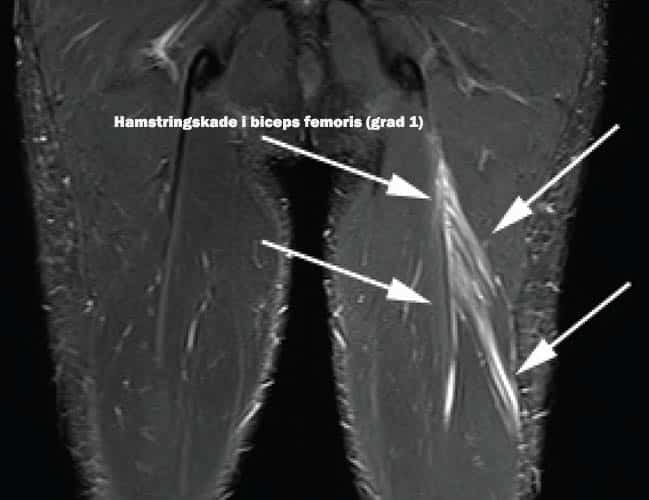
Pain in the thigh
Pain in the thigh and nearby structures can be painful. Pain in the thigh can be caused, among other things, by muscle strain, tendon damage, nerve irritation in the back or seat, as well as joint locking in the pelvis or hip.
Some of the most common causes are congestion, trauma, wear and tear, muscular failure and mechanical dysfunction. Thigh pain and thigh pain can affect anyone, but there is still a higher risk for people who play sports.
TIP: Further down in the article you will find a video with good training exercises for you with thigh pain.
Where in the thigh do you have pain?
Based on where in the thigh the pain is, for example front and back, or on the outside - then you can start the process of estimating possible diagnoses. For example, pain on the outside of the thigh can be related to ITB syndrome and muscular tension in what we call the musculus tensor fascia latae (TFL). Pain in the front of the thigh suggests problems with the accumulation of anterior thigh muscles called quadriceps (divided into 4 muscles). Pain in the back of the thigh can originate from the muscle group we call the hamstrings (consisting of 3 muscles).
Our clinic departments at Vondtklinikkene (click here for a complete overview of our clinics), including in Oslo (Lambert seats) and Viken (Eidsvoll Sound og Raw wood), has a distinctively high level of professional expertise in the investigation, treatment and rehabilitation of thigh problems and muscle injuries. Contact us if you want the help of therapists with expertise in these areas.
Did you know that several of the muscles in the hips and groin can cause pain down towards the thigh? A little further down in the article shows chiropractor Alexander Andorff came up with a good training program with exercises to strengthen the supporting muscles in the thighs, hips and groin.
VIDEO: 10 Strength Exercises against Painful Hips and Thighs
Click here to watch a video of a training program for pain in the hips and thighs. After all, hip training is one of the most important things you can do to prevent thigh pain.
Join our group of friends and subscribe to our YouTube channel for free exercise tips, exercise programs and health knowledge. Welcome!
In this article you can read more about the following topics:
Thigh anatomy
+ The back of the thigh
+ The front of the thigh
+ Inner thigh
+ The outside of the thigh
Self-treatment against Tight Thigh Muscles
Possible Causes and Diagnoses of Thigh Pain
Common Symptoms and Pain Presentations
Investigation and Examination of Pain in the Thigh
+ Functional Examination
+ Imaging examination (if medically indicated)
Treatment for Pain in the Thigh
Exercises and training against thigh pain
Where's the thigh?
The thigh is the upper part of the leg, and is divided into front, back, inside and outside. Here we take a closer look at which structures we find on the various parts of the thigh.
– On the Back of the Thigh (Back Thigh)

(Figure 1: Illustration of the hamstring muscles on the back of the thigh, as well as the position of the sciatic nerve)
The three sit, among other things, on the back of the thigh hamstring muscles (biceps femoris, semitendinosus and semimembranosus). The hamstrings are also known as the knee flexors as they are responsible for bending your knees. In many people, these muscles can become excessively tense and not very elastic - which in turn can lead to increased problems with the back and hips. This is also an area that can be troubled by strain injuries and muscle tears. We also want to show that the sciatic nerve also passes through the back of the thigh.
– On the Front of the Thigh (Front Thigh)

(Figure 2: Illustration of the 4 quadriceps muscles on the front of the thigh - towards the outside of the thigh we also see the iliotibial band, as well as the tensor fasciae latae)
In the front thigh we find the four quadriceps muscles (rectus femoris, vastus lateralis, vastus medialis and vastus intermedius) which can all cause pain in the thigh if there is muscle damage or muscle knots in the area. The quadriceps muscles are also known as the knee extensors - and are therefore the main muscles that help you extend your leg. Good strength in the thigh muscles is therefore absolutely essential for shock absorption for knees and hips. In the upper part of the front of the thigh we also find the iliopsoas (hip flexor).
– On the Inside of the Thigh
Towards the inside of the thigh are the adductor muscles (adductor brevis, adductor longus and adductor magnus). Here we also find the gracilis, which can cause pain on the upper, inside of the thigh - including the groin. In fact, muscle tension and muscle damage on the inside of the thigh is one of the most common causes of groin pain. In addition to this, it can also contribute to pain on the inside of the knee.
– The outside of the Thigh
Located on the outer part of the thigh, we find the musculus tensor fascia latae and the iliotibial band. Malfunction and tensions in these can give rise to a diagnosis known as ITB syndrome, which can cause pain from the outside of the thigh all the way down to the outside of the knee. A common self-treatment technique for this part of the musculature can include roll a massage ball towards the tense muscle fibers.
Self-treatment against Tight Thigh Muscles
First and foremost, we strongly encourage persistent pain to be investigated by an authorized clinician (preferably a physiotherapist or chiropractor). But if you have a fairly clear indication that it is due to muscular tension or minor muscle tears, then we can give you some good advice for self-measures first and last.
Tip 1: Dissolve muscle tension with Trigger point ball (The link opens in a new window)
Many of us suffer from tense muscles and muscle tension. Working on these regularly can reduce the chance of muscle pain and contribute to improved muscular function. Self-use of a massage ball aimed at the muscles can help to stimulate blood circulation and dissolve tense muscles. Place the ball against the tense muscles and roll on it for 30-60 seconds per area. Click on the image or link to read more about how daily use of massage balls can be beneficial against muscular tension.
In addition to this, specific rehabilitation exercises can be included minibands (link opens in new window) be beneficial for better function of muscles and tendons in the thighs. The reason for this is that they help you to isolate the right muscles in the thighs - and in this way make the training both more effective and gentle at the same time. If necessary, we recommend reusable heat / cold pack to stimulate the muscles with increased blood circulation. You heat the heat pack easily and simply in the microwave, which you then place against the thigh muscles.
Causes and Diagnoses of Pain in the Thigh
It is important to distinguish between the more common and unusual diagnoses as a cause of pain in the thigh. Among the most common causes of pain in the thigh are muscle tension, muscle damage, tendon problems and tendon damage. You can get more information about your complaints and symptoms by having the complaints investigated by an authorized clinician, such as a modern chiropractor or physiotherapist. At our associated clinical departments The pain clinics we are always ready to help you.
Possible Diagnoses for Pain in the Thigh
- Osteoarthritis (The pain depends on which joints are affected, but upper thigh pain may be due osteoarthritis of the hip)
- pelvic locker (pelvic lock with associated myalgia can cause pain on the outside and back of the thigh)
- Gluteal myalgia (pain in back of thigh, in transition to seat / glutes)
- Hamstrings myalgia / Muscular injury (causes pain on the back of the thigh, depending on which area is damaged)
- Iliopsoas bursitis / mucus inflammation (often results in reddish swelling in the area, night pain and extreme pressure)
- Iliopsoas / hip flexors myalgia (Muscle dysfunction in the iliopsoas will often cause pain in the upper thigh, front, against the groin)
- Sciatica
- ITB syndrome
- Muscle tear
- Muscular tension
- Joint locker in the pelvis, hip or lower back
- Lumbar prolapse (nerve irritation / disc injury in the L3 or L4 nerve root can cause referred pain in the thigh)
- Piriformis syndrome (functional nerve irritation in the seat)
- Tendinitis (tendinitis)
- Tendon damage (tendinosis)
- Quadriceps myalgia / muscle injury
Rare Causes of Thigh Pain
- hip fracture
- Infection (often with high CRP and fever)
- Cancer
Possible Symptoms and Pain Presentations for Thigh Pain
- Deafness in the thigh
- Burning in the thigh
Deep pain in the thigh
Electric shock in the thigh
- Hogging i the thigh
- Knute i the thigh
- Cramps in the thigh
- Murring i the thigh
- Nummen i the thigh
- Tired i the thigh
Stitching in the thigh
Støl i the thigh
- Wounds in the thigh
- Effect i the thigh
Tender in the thigh
Investigation and Examination of Pain in the Thigh
Functional Examination
Imaging Diagnostic Examination (if medically indicated)
Anamnesis and Functional Examination
An investigation will always start with your clinician taking a history. Here, the therapist will hear more about your symptoms and pain, as well as ask relevant questions to better understand the pain situation. The therapist then moves on and checks the function of your thigh, as well as nearby structures. This may involve mobility testing, palpation, muscle testing and specialist orthopedic tests to map where your pain is coming from.
Imaging diagnostic examination of thigh pain
Sometimes imaging (x-ray, MRI, CT or diagnostic ultrasound) may be necessary to determine the exact cause of the problem. Normally, you will manage without taking pictures of the thigh - but it is relevant if there is a suspicion of muscle damage, fracture of the femur or lumbar prolapse. In certain cases, an X-ray is also taken with the aim of checking changes in wear and tear and possible fractures. Below you can see various pictures of how the thigh looks in the different forms of examination.
X-ray of the thigh / femur (from front, AP)

- Description: X-ray image of the thigh, frontal angle (viewed from the front), in the image we see the neck and head of the femur, the major and minor tuberosities, as well as the femur itself.
Photo: Wikimedia / Wikifoundry
X-ray of the thigh (from the side)
- Description: X-ray image of the thigh, lateral angle (seen from the side), in the image we see the neck and head of the femur, the major and minor tuberosities, as well as the femur itself and the tibial bone. We also see the kneecap (patella) and the lateral and medial condyle of the knee.
MR image of hamstring injury (Grade 1 hamstring rupture)
- Description: MR image of a hamstring injury, frontal angle (viewed from the front), on the image we see an injury in the biceps femoris, one of the three hamstring muscles.
MRI of thigh and calf - cross section
– Description: MR image of thigh (left) and calf (right).
CT image of cancer of the thigh (sarcoma - a form of bone cancer)
Here we see a CT examination of the thigh, in a so-called cross-section. The picture shows a sarcoma, a very rare form of bone or soft tissue cancer.
Diagnostic ultrasound of the thigh
Here we see a diagnostic ultrasound examination of the thigh. The examination shows a muscle injury in the adductor muscles (on the inside of the thigh).
Treatment for Thigh Pain
Holistic, interdisciplinary and evidence-based treatment
Important with rehabilitation exercises for long-term recovery
Holistic and modern treatment
By The pain clinics we are concerned that all our therapists have a large toolbox - with a distinctively good treatment expertise, which includes muscles, tendons, nerves and joints. In this way, our clinicians are better suited to treat and rehabilitate more complex pain presentations and complicated injuries. Modern treatment of thigh pain will often include muscular techniques, often using Shockwave, as well as intramuscular acupuncture (also known as sports acupuncture).
Sports acupuncture: An effective supplement
At our clinics, our therapists have very good expertise in intramuscular acupuncture. A study published in 2015 (Pavkovich et al) showed that dry needling combined with stretching and exercises had symptom-relieving and function-improving effects in patients with chronic thigh and hip pain.
Specific Rehabilitation Exercises: Basis for Long-Term Recovery
The treatment is further combined with specific rehabilitation exercises based on the clinical findings in the functional examination. These have primarily seen it as their main task to strengthen the injury-prone areas and ensure that the risk of similar injuries and pain occurring again at a later date is reduced.
List of treatments (both much alternative and more conservative)
In the list below, we show the range of treatment methods that are out there. It is safest to deal with publicly authorized clinicians, such as chiropractors and physiotherapists, as these professions have title protection and have extensive training.
- acupressure
- Acupuncture
- aromatherapy
- behavioral therapy
- Atlas Correction
- Ayurvedic medicine
- Bioelectromagnetic therapy
- blockade Treatment
- Soft tissue work
- Bowen Treatment
- Coxtherapy
- Electrotherapy
- Ergonomics
- Dietology
- Reflexology
- Physiotherapy
- gonstead
- Healing
- home Practice
- Homeopathy
- Hydrotherapy
- hypnotherapy
- Infrared light therapy
- insoles
- Intramuscular needle therapy
- Ice therapy
- remedy
- kinesiology
- Kinesiotape
- chiropractic
- Cognitive processing
- crystal Therapy
- contrast Treatment
- Cupping
- Cold Treatment
- Laser
- Joint Correction
- Joint Mobilization
- Medical treatment
- Lymphatic drainage
- Light Therapy
- magnet Treatment
- manual Therapy
- Meditation
- Muscle Relaxing Medications
- muscle Knute treatment
- Myofascial technique
- Naprapathy
- Naturopathy
- Neurological rehabilitation training
- qigong
- Osteopathy
- breathing
- reflexology
- Shockwave Therapy
- Pain medication
- Spinology
- Sports support
- Stretch bench
- Power Management
- sole Customization
- Thought Field Therapy
- TENS
- Thai Massage
- Traction
- Exercise
- Trigger point therapy
- Shockwave Therapy
- Dry needle
- stretching
- heat treatment
- Hot water therapy
- Yoga
- Exercises
- Pain clinics: Our clinics and therapists are ready to help you

Click on the link below to see an overview of our clinic departments. At Vondtklinikkene Tverrfaglig Helse, we offer assessment, treatment and rehabilitation training, for, among other things, muscle diagnoses, joint conditions, nerve pain and tendon disorders. With us, it is always the patient who is most important - and we look forward to helping you.
References, Research and Sources
1. Pavkovich et al (2015). Effectiveness of Dry Needling, Stretching, and Strengthening to Reduce Pain and Improve Function in Subjects with Chronic Lateral Hip and Thigh Pain: A Retrospective Case Series. Int J Sports Phys Ther. 2015 Aug; 10(4): 540–551.
Frequently asked questions regarding Thigh pain (FAQ)
Feel free to use the comments section below to ask questions. Or send us a message via social media or one of our other contact options.
Question: I have pain in the upper part of the front of my thigh. What could be the cause?
Answer: Without more information, it is impossible to give a specific diagnosis, but depending on the prehistory (was it trauma? Has it been long-lasting?) There can be a number of causes of pain in the upper part of the front of the thigh. Among other things, quadriceps stretching or muscle injury. There may also be referred pain from nearby structures in the hip or pelvis - iliopsoas mucositis is also a possible cause.
Question: Have painful points on sides of thighs. What could be the diagnosis and cause of pain on the outside of the thigh?
Answer: The most common causes of tight and painful muscles on the outside of the thighs are iliotibial band syndrome og myalgias / muscle tension in that part of the quadriceps we call vastus lateralis. Other possible causes are sciatica irritation or referenced pain from lower back nerves, but these will most often cause more characteristic nerve pain such as numbness, tingling, radiation and sensation of electric shocks or bumps.
Question: What can be done about pain in the thighs? Which treatment works best if you have thigh pain?
Answer: What should be done and what treatment is carried out depends on what is causing the pain. If the thigh pain is due to tight, dysfunctional thigh muscles, the solution is often physical treatment - but if the cause is nerve pain originating from the lower back, it will be natural to primarily address the back and the thigh in the treatment setup and choice of treatment.
Question: Can foam rolling help my thigh pain?
Answer: Yes, a foam roller or trigger point ball can help you quite a bit along the way, but if you have a problem with your thigh, we recommend that you contact a qualified healthcare professional within the musculoskeletal field and get a qualified treatment plan with associated specific exercises. Foam roller is often used on the outside of the thigh, against the iliotibial band and tensor fascia latae.
Question: Why do you get thigh problems?
Answer: Pain is the body's way of saying that something is wrong. Thus, pain signals must be interpreted as a form of dysfunction in the area involved, which should be investigated and further improved with appropriate treatment and training. Causes of pain in the thigh can be due to sudden improper loading or gradual improper loading over time, which can lead to increased muscle tension, joint stiffness, nerve irritation and, if things have gone far enough, discogenic rashes (nerve irritation / nerve pain due to disc disease in the lower back, so-called lumbar prolapse with affection towards the L3 or L4 nerve root).
Question: What should be done with a sore thigh full of muscle knots?
Reply: muscle knots has most likely occurred due to muscle imbalance or incorrect load. Associated muscle tension can also occur around joint locks in the nearby hip and pelvic joints. Initially, you should get qualified treatment, and then get specific exercises and stretching so that it does not become a recurring problem later in life.
Question: Woman, 37 years old, with pain on the front of the left thigh. What could it be?
Answer: If the pain is closer to the groin, it may be an iliopsoas myalgia or bursitis / mucositis - it can also be referred to referred pain from dysfunction in the hip or pelvis. If the pain is more in the middle of the front of the thigh, it may be the quadriceps that is injured or overloaded. Lumbar prolapse (lumbar prolapse) can also refer to pain in the front of the left thigh if the left L3 nerve root is affected or irritated.
Question: Male, 22 years old, with a sore thigh muscle on the right side. What could be the cause?
Answer: The most common cause of sore thigh muscles is overload without sufficient supporting muscles. Perhaps you have increased the length and intensity of your training too quickly? The most common muscles that can hurt in the thigh are the iliopsoas (hip flexors), TFL (tensor fascia latae) and the four quadriceps muscles. If the pain is in the back, it is most likely the hamstring muscles.
 - Follow Vondtklinikkene Verrfaglig Helse at YOUTUBE
- Follow Vondtklinikkene Verrfaglig Helse at YOUTUBE
 - See Vondtklinikkene Interdisciplinary Health at FACEBOOK
- See Vondtklinikkene Interdisciplinary Health at FACEBOOK
 - Follow Chiropractor Alexander Andorff on FACEBOOK
- Follow Chiropractor Alexander Andorff on FACEBOOK










Leave a reply
Want to join the discussion?Feel free to Contribute!